Manual of Structural Kinesiology Neuromuscular Fundamentals 2 -2


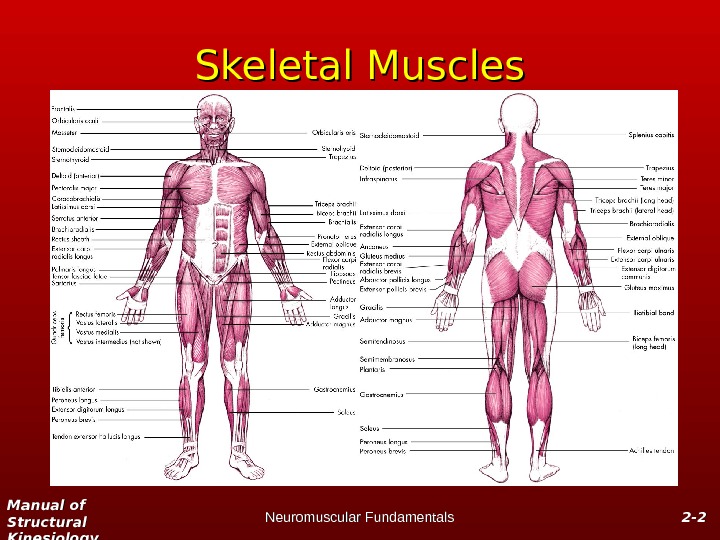
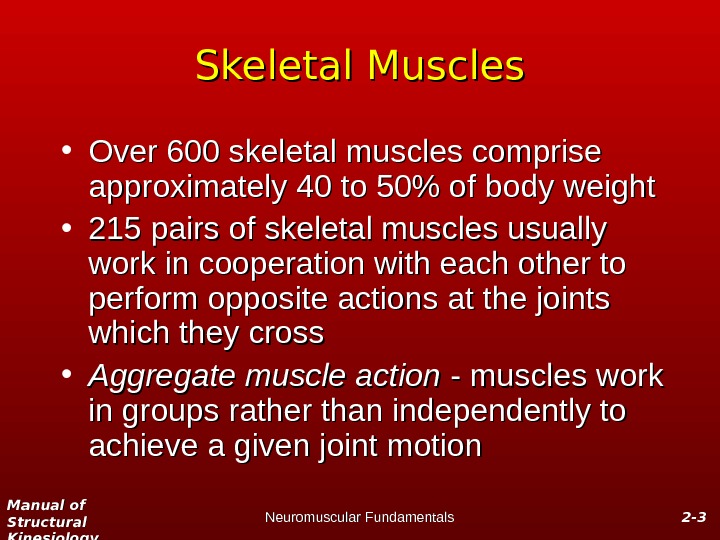
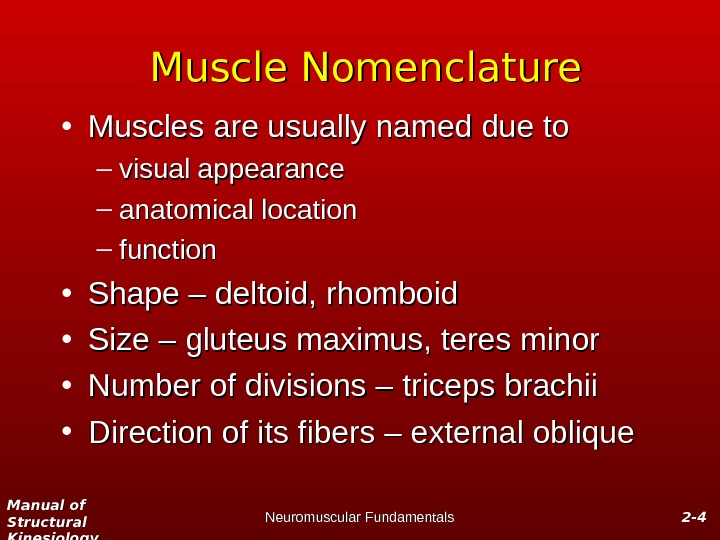
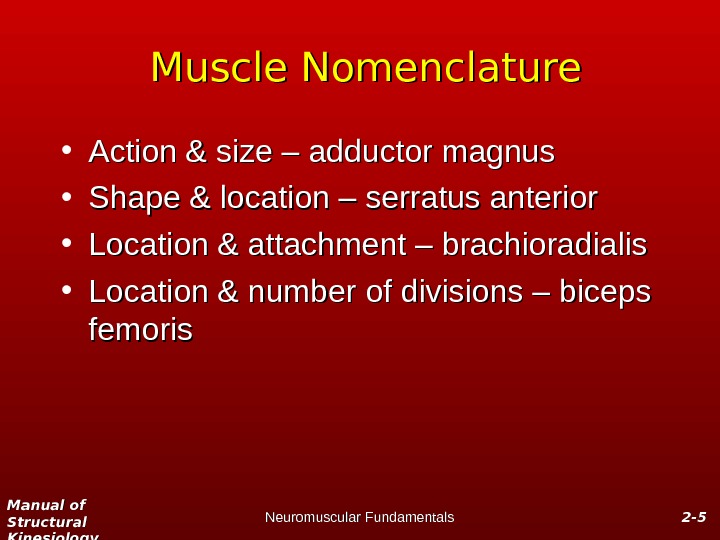
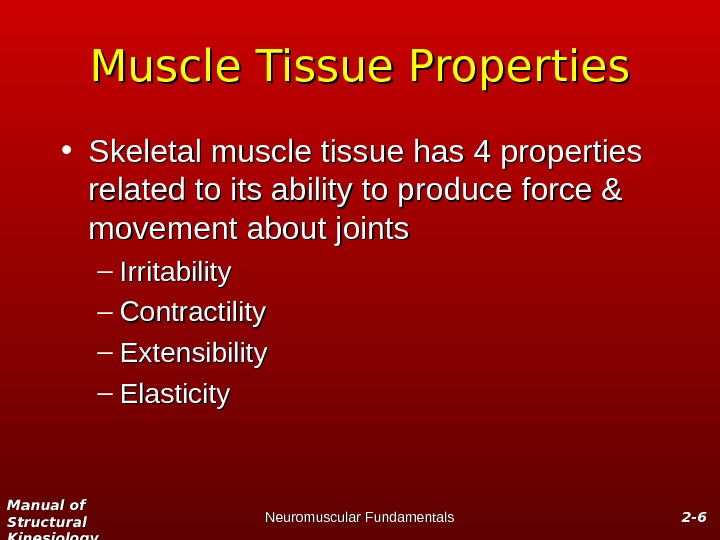
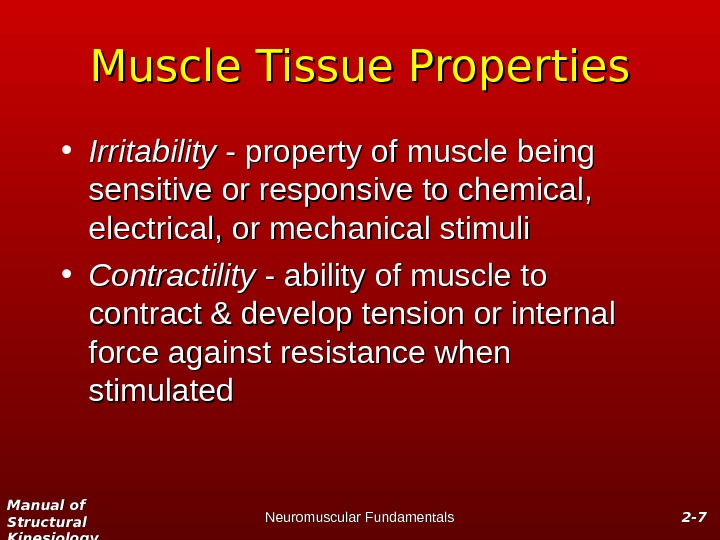






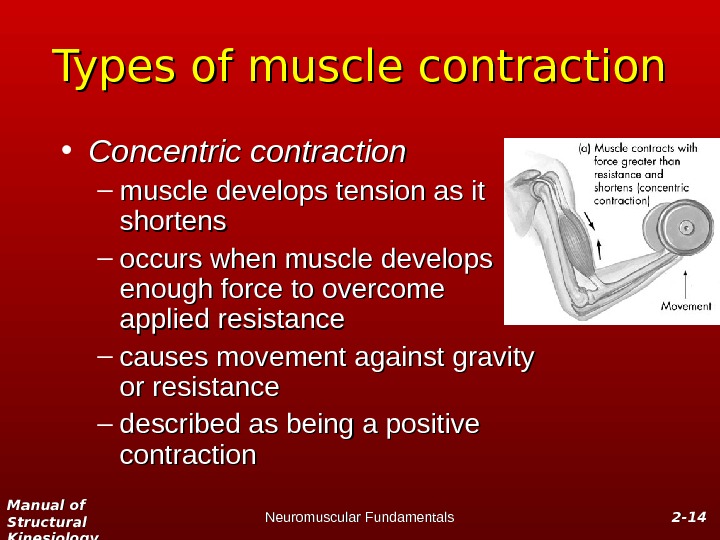

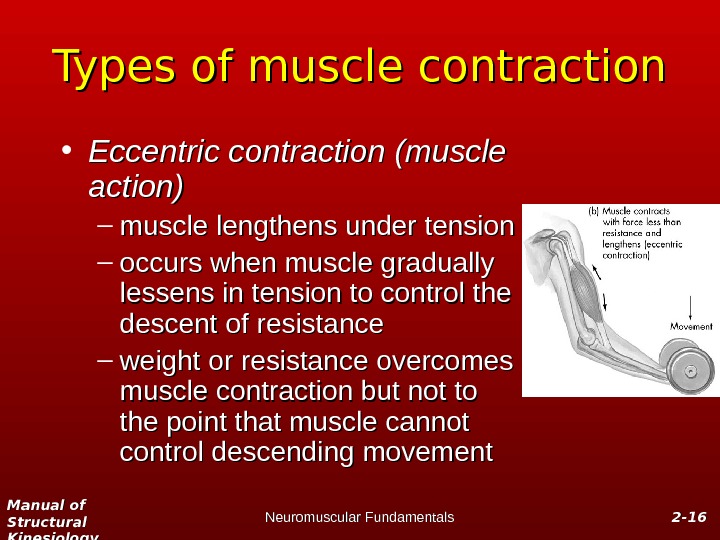

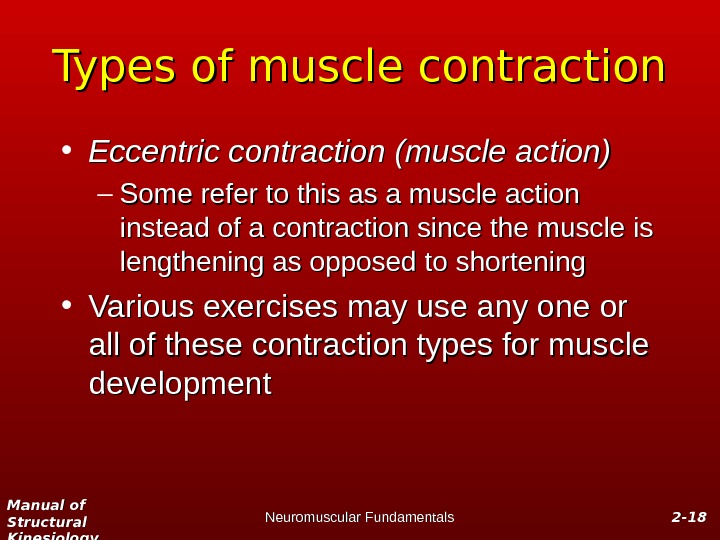
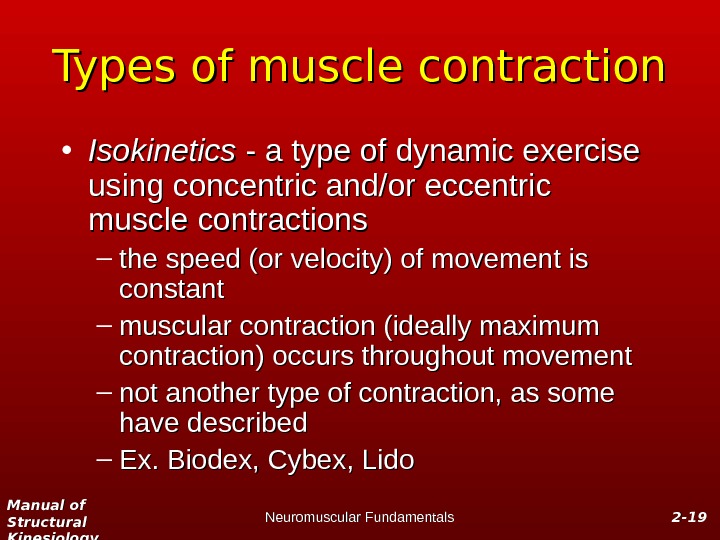
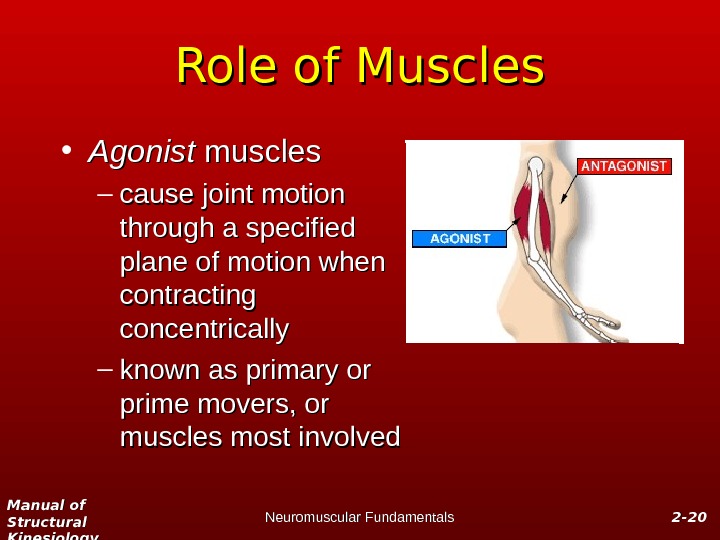



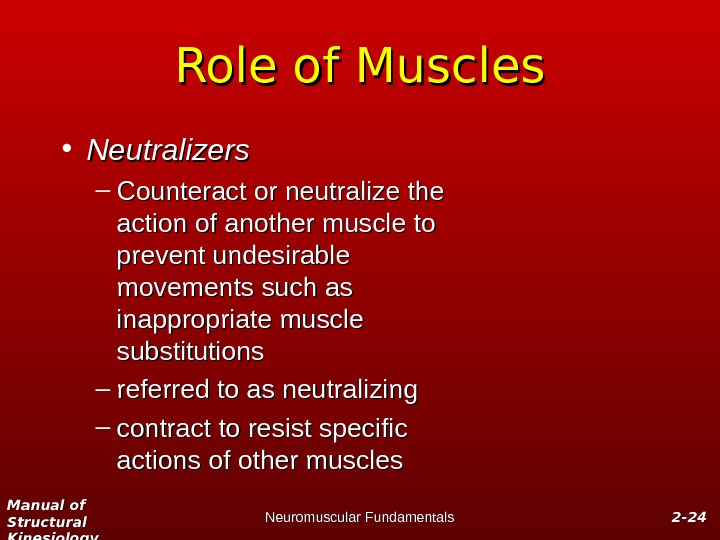
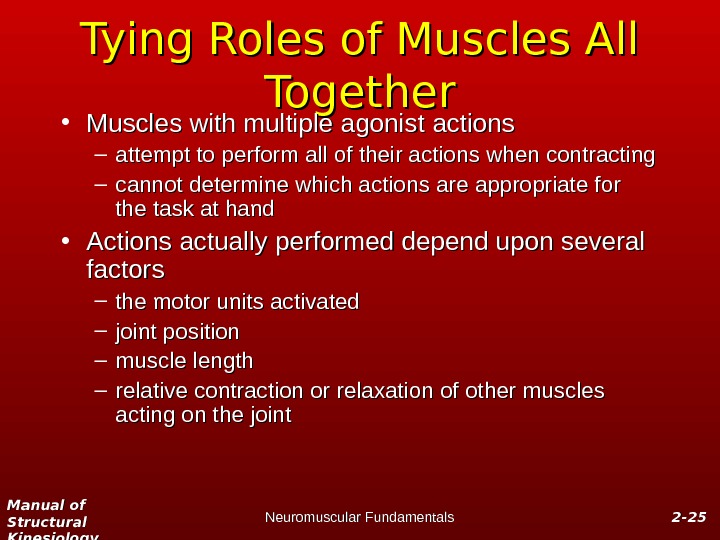

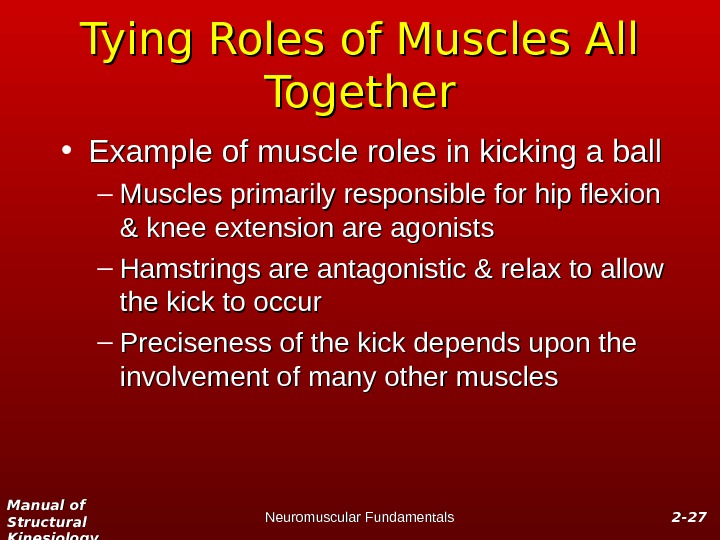
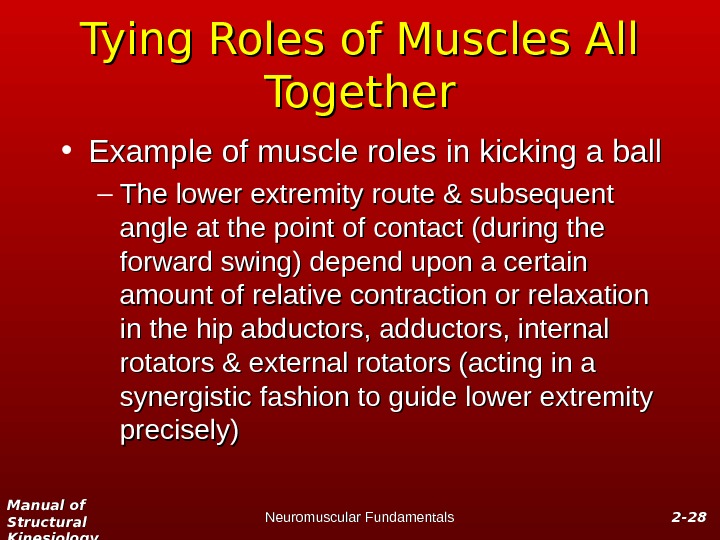

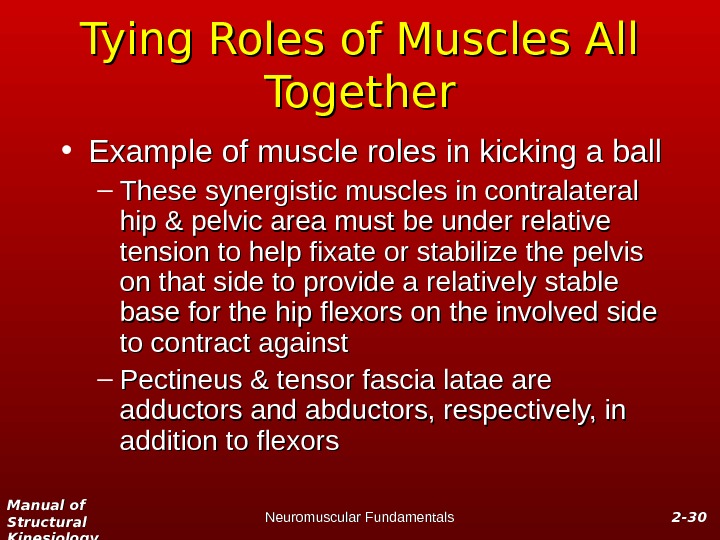
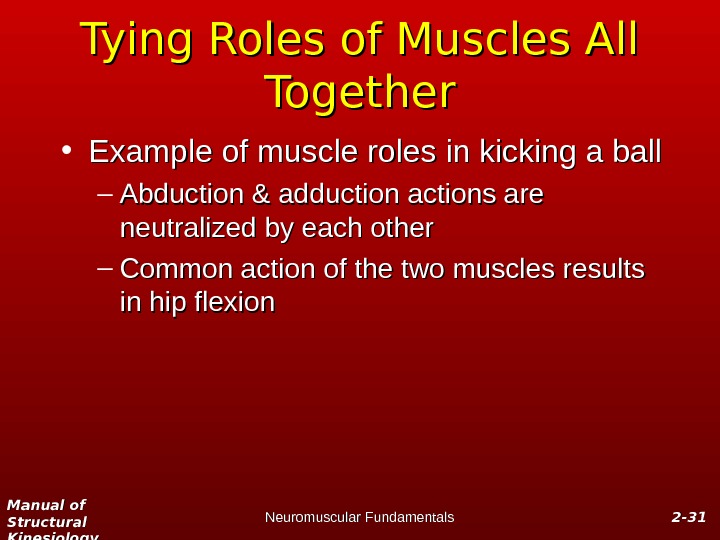

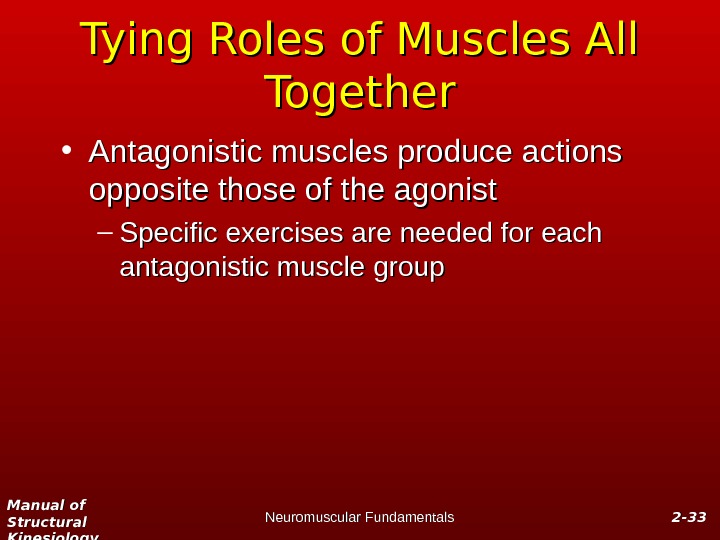


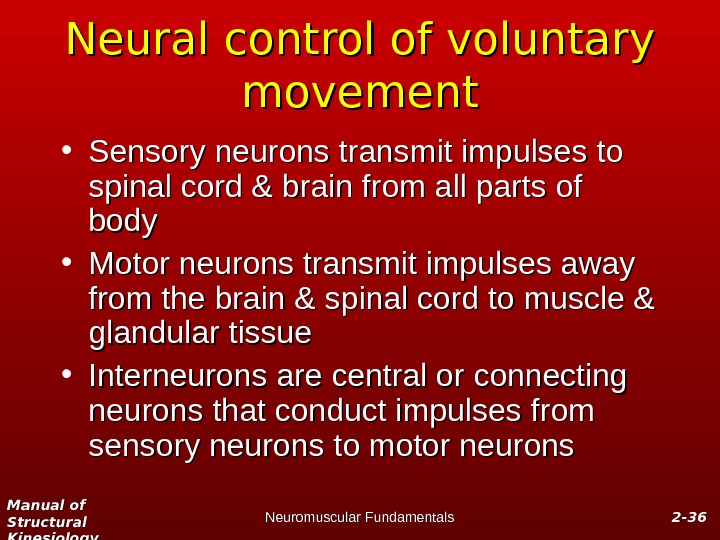


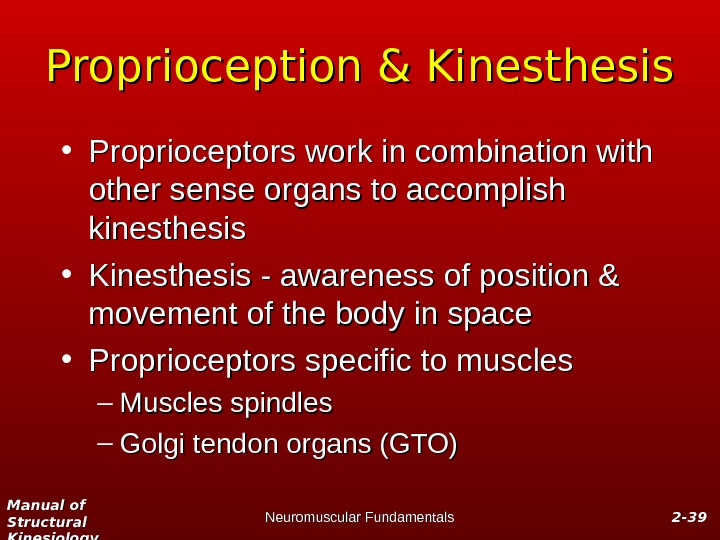
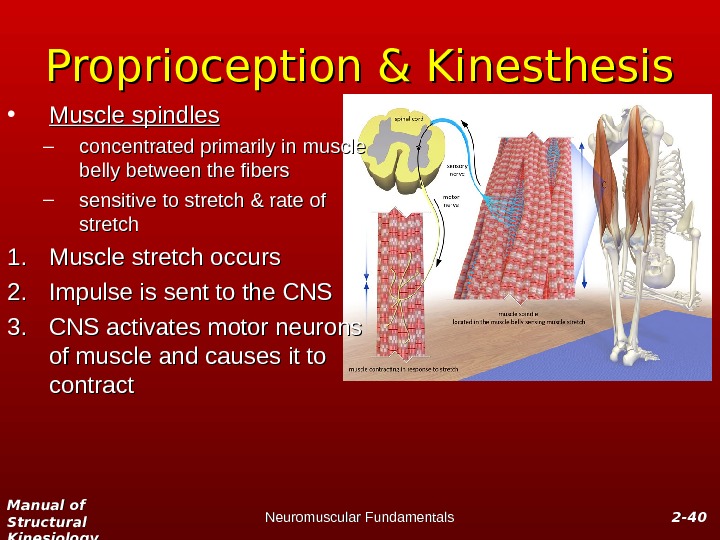


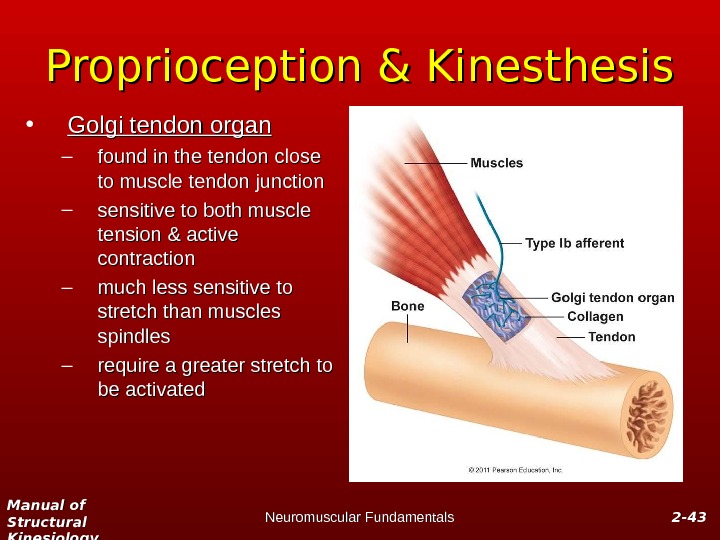
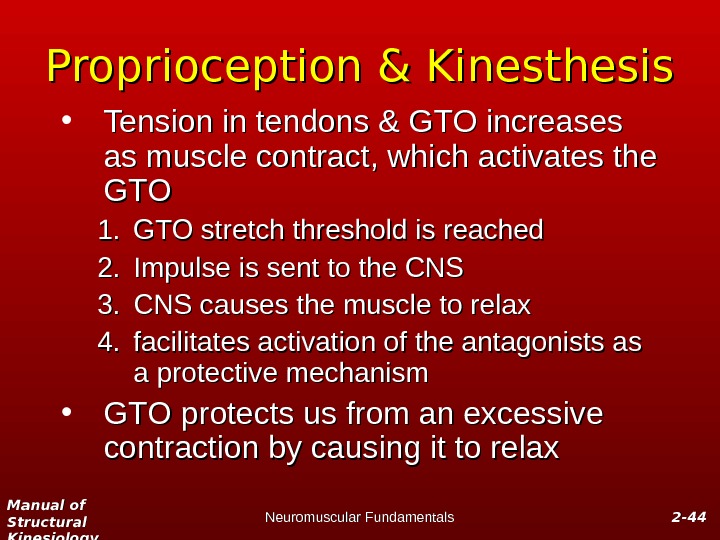

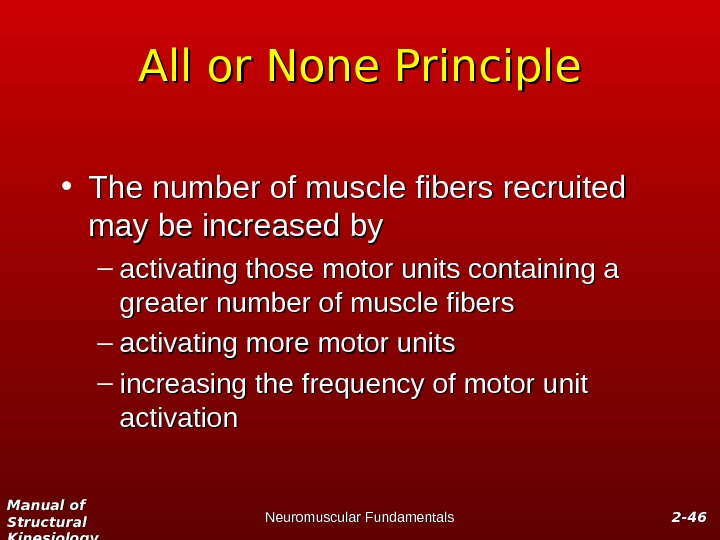

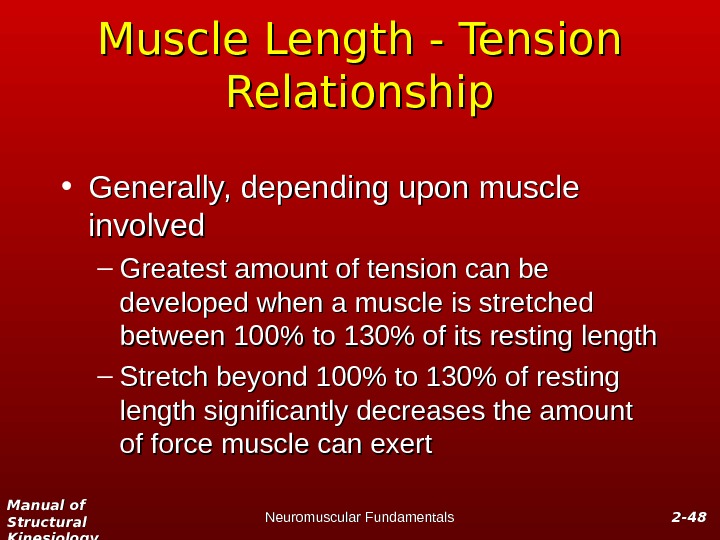

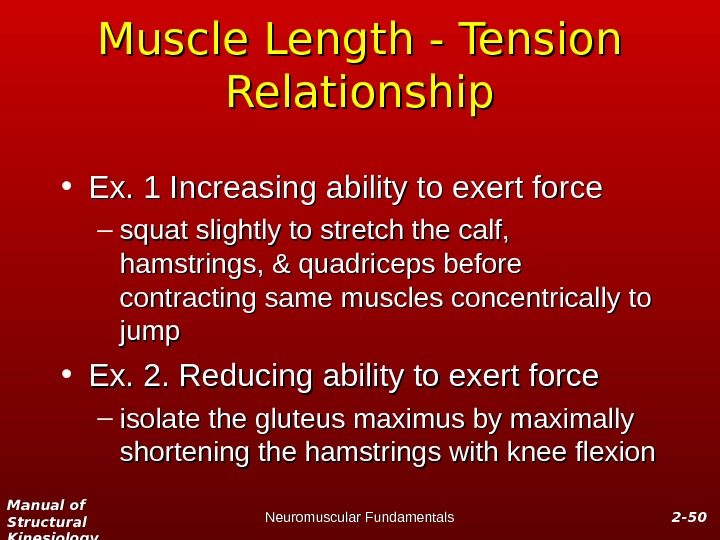
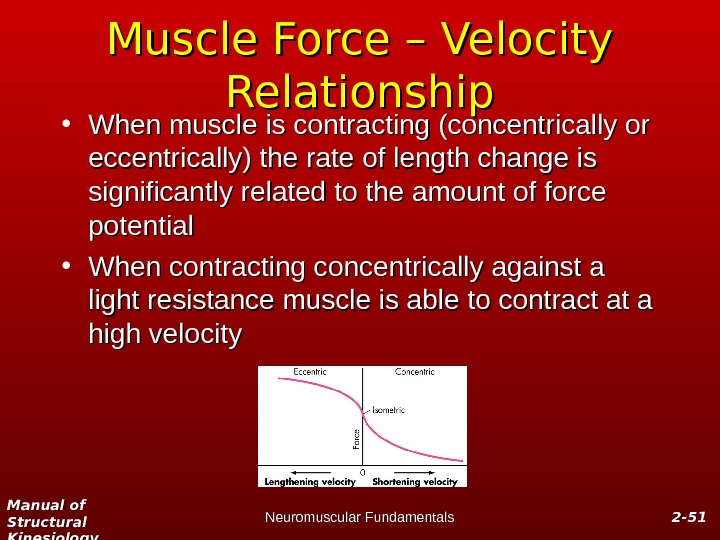


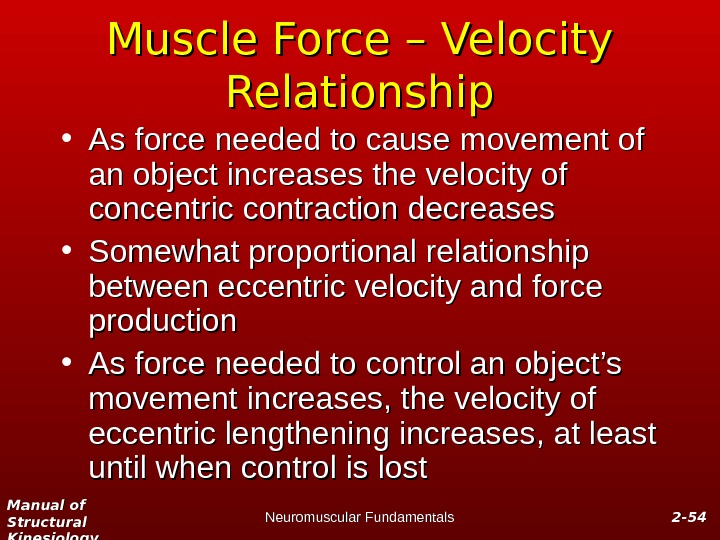

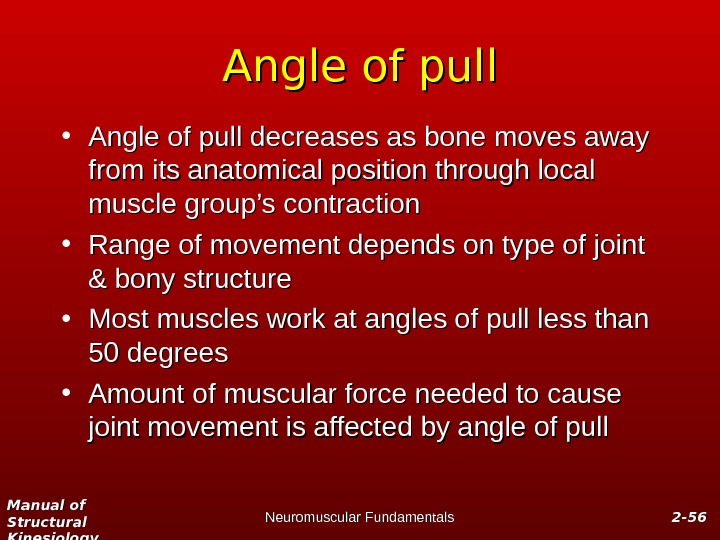

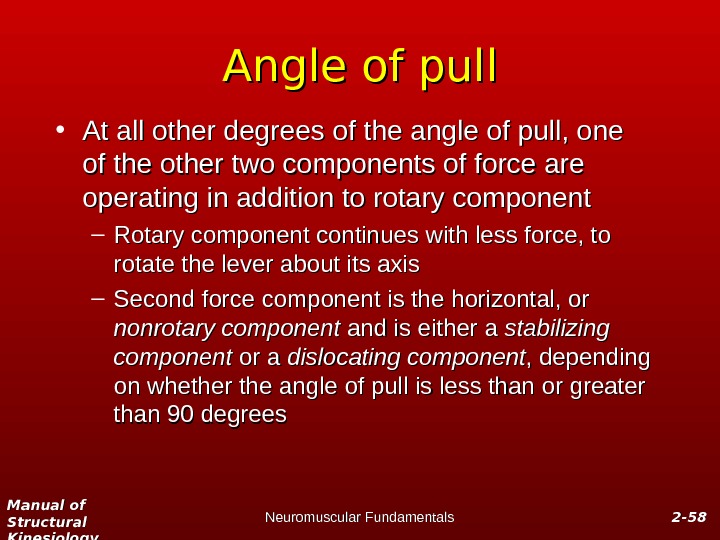







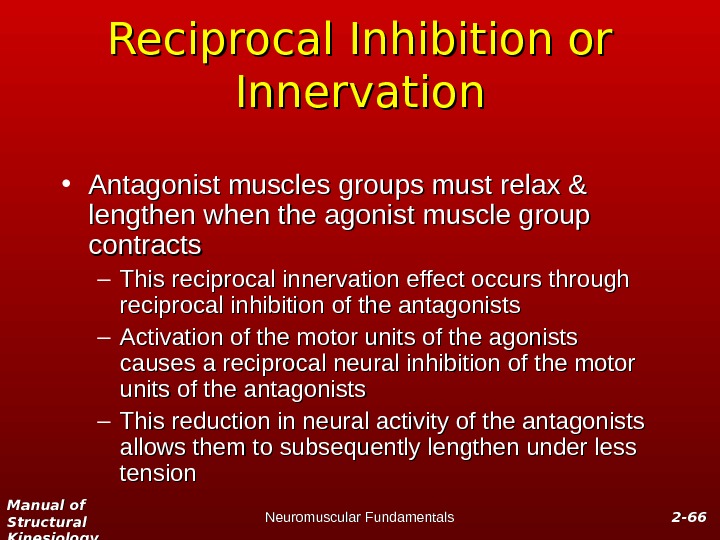


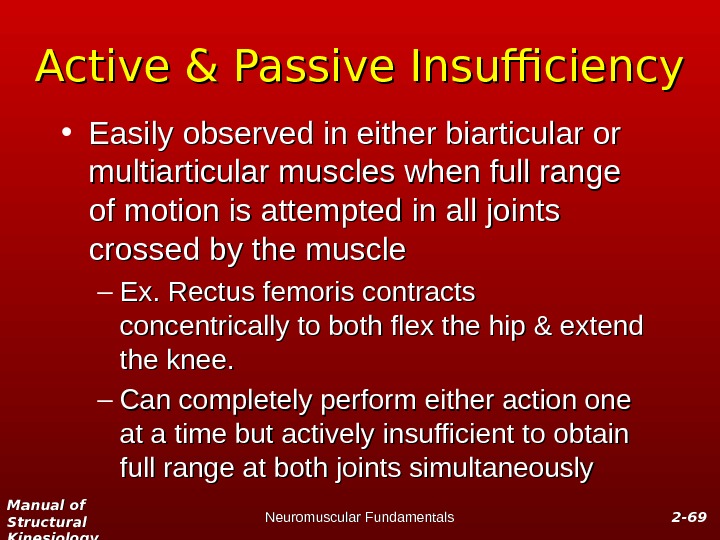
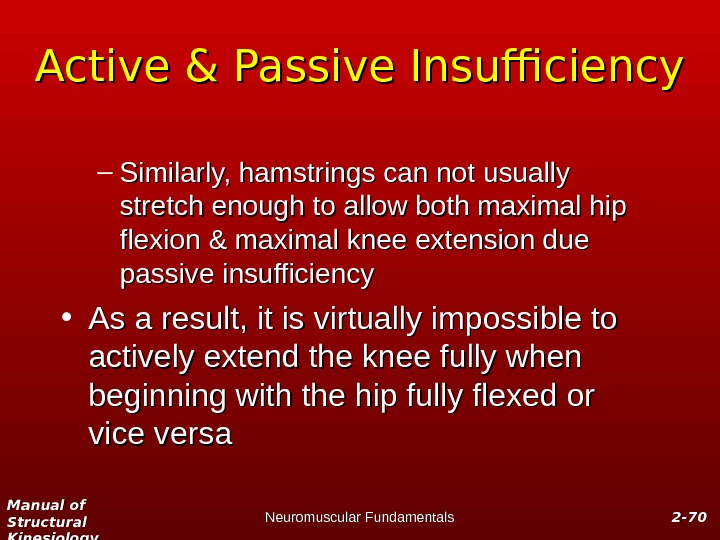

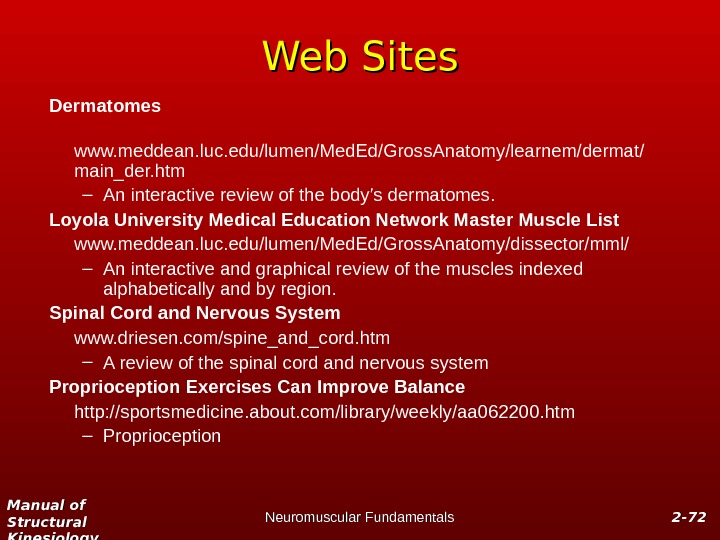

kinesiology-_syon_final_02.ppt
- Размер: 3.4 Mегабайта
- Количество слайдов: 73
Описание презентации Manual of Structural Kinesiology Neuromuscular Fundamentals 2 -2 по слайдам
 Manual of Structural Kinesiology Neuromuscular Fundamentals 2 -2 — 11 Skeletal Muscles • Responsible for movement of body and all of its joints • Muscle contraction produces force that causes joint movement • Muscles also provide – protection – posture and support – produce a major portion of total body heat
Manual of Structural Kinesiology Neuromuscular Fundamentals 2 -2 — 11 Skeletal Muscles • Responsible for movement of body and all of its joints • Muscle contraction produces force that causes joint movement • Muscles also provide – protection – posture and support – produce a major portion of total body heat
 Manual of Structural Kinesiology Neuromuscular Fundamentals 2 -2 — 22 Skeletal Muscles
Manual of Structural Kinesiology Neuromuscular Fundamentals 2 -2 — 22 Skeletal Muscles
 Manual of Structural Kinesiology Neuromuscular Fundamentals 2 -2 — 33 Skeletal Muscles • Over 600 skeletal muscles comprise approximately 40 to 50% of body weight • 215 pairs of skeletal muscles usually work in cooperation with each other to perform opposite actions at the joints which they cross • Aggregate muscle action — muscles work in groups rather than independently to achieve a given joint motion
Manual of Structural Kinesiology Neuromuscular Fundamentals 2 -2 — 33 Skeletal Muscles • Over 600 skeletal muscles comprise approximately 40 to 50% of body weight • 215 pairs of skeletal muscles usually work in cooperation with each other to perform opposite actions at the joints which they cross • Aggregate muscle action — muscles work in groups rather than independently to achieve a given joint motion
 Manual of Structural Kinesiology Neuromuscular Fundamentals 2 -2 — 44 Muscle Nomenclature • Muscles are usually named due to – visual appearance – anatomical location – function • Shape – deltoid, rhomboid • Size – gluteus maximus, teres minor • Number of divisions – triceps brachii • Direction of its fibers – external oblique
Manual of Structural Kinesiology Neuromuscular Fundamentals 2 -2 — 44 Muscle Nomenclature • Muscles are usually named due to – visual appearance – anatomical location – function • Shape – deltoid, rhomboid • Size – gluteus maximus, teres minor • Number of divisions – triceps brachii • Direction of its fibers – external oblique
 Manual of Structural Kinesiology Neuromuscular Fundamentals 2 -2 — 55 Muscle Nomenclature • Action & size – adductor magnus • Shape & location – serratus anterior • Location & attachment – brachioradialis • Location & number of divisions – biceps femoris
Manual of Structural Kinesiology Neuromuscular Fundamentals 2 -2 — 55 Muscle Nomenclature • Action & size – adductor magnus • Shape & location – serratus anterior • Location & attachment – brachioradialis • Location & number of divisions – biceps femoris
 Manual of Structural Kinesiology Neuromuscular Fundamentals 2 -2 — 66 Muscle Tissue Properties • Skeletal muscle tissue has 4 properties related to its ability to produce force & movement about joints – Irritability – Contractility – Extensibility – Elasticity
Manual of Structural Kinesiology Neuromuscular Fundamentals 2 -2 — 66 Muscle Tissue Properties • Skeletal muscle tissue has 4 properties related to its ability to produce force & movement about joints – Irritability – Contractility – Extensibility – Elasticity
 Manual of Structural Kinesiology Neuromuscular Fundamentals 2 -2 — 77 Muscle Tissue Properties • Irritability — property of muscle being sensitive or responsive to chemical, electrical, or mechanical stimuli • Contractility — ability of muscle to contract & develop tension or internal force against resistance when stimulated
Manual of Structural Kinesiology Neuromuscular Fundamentals 2 -2 — 77 Muscle Tissue Properties • Irritability — property of muscle being sensitive or responsive to chemical, electrical, or mechanical stimuli • Contractility — ability of muscle to contract & develop tension or internal force against resistance when stimulated
 Manual of Structural Kinesiology Neuromuscular Fundamentals 2 -2 — 88 Muscle Tissue Properties • Extensibility — ability of muscle to be stretched back to its original length following contraction • Elasticity — ability of muscle to return to its original length following stretching
Manual of Structural Kinesiology Neuromuscular Fundamentals 2 -2 — 88 Muscle Tissue Properties • Extensibility — ability of muscle to be stretched back to its original length following contraction • Elasticity — ability of muscle to return to its original length following stretching
 Manual of Structural Kinesiology Neuromuscular Fundamentals 2 -2 — 99 Muscle Terminology • Origin — — proximal attachment, generally considered the least movable part or the part that attaches closest to the midline or center of the body • Insertion — — distal attachment, generally considered the most movable part or the part that attaches farthest from the midline or center of the body
Manual of Structural Kinesiology Neuromuscular Fundamentals 2 -2 — 99 Muscle Terminology • Origin — — proximal attachment, generally considered the least movable part or the part that attaches closest to the midline or center of the body • Insertion — — distal attachment, generally considered the most movable part or the part that attaches farthest from the midline or center of the body
 Manual of Structural Kinesiology Neuromuscular Fundamentals 2 -2 — 1010 Types of muscle contraction • All muscle contractions are either isometric or isotonic • Isometric contraction – tension is developed within muscle but joint angles remain constant – static contractions – significant amount of tension may be developed in muscle to maintain joint angle in relatively static or stable position
Manual of Structural Kinesiology Neuromuscular Fundamentals 2 -2 — 1010 Types of muscle contraction • All muscle contractions are either isometric or isotonic • Isometric contraction – tension is developed within muscle but joint angles remain constant – static contractions – significant amount of tension may be developed in muscle to maintain joint angle in relatively static or stable position
 Manual of Structural Kinesiology Neuromuscular Fundamentals 2 -2 — 1111 Types of muscle contraction Muscle Contraction (under tension) Isometric Isotonic Eccentric Concentric
Manual of Structural Kinesiology Neuromuscular Fundamentals 2 -2 — 1111 Types of muscle contraction Muscle Contraction (under tension) Isometric Isotonic Eccentric Concentric
 Manual of Structural Kinesiology Neuromuscular Fundamentals 2 -2 — 1212 Types of muscle contraction • Isotonic contractions involve muscle developing tension to either cause or control joint movement – dynamic contractions – the varying degrees of tension in muscles are causing joint angles to change • Isotonic contractions are either concentric or eccentric on basis of whether shortening or lengthening occurs
Manual of Structural Kinesiology Neuromuscular Fundamentals 2 -2 — 1212 Types of muscle contraction • Isotonic contractions involve muscle developing tension to either cause or control joint movement – dynamic contractions – the varying degrees of tension in muscles are causing joint angles to change • Isotonic contractions are either concentric or eccentric on basis of whether shortening or lengthening occurs
 Manual of Structural Kinesiology Neuromuscular Fundamentals 2 -2 — 1313 Types of muscle contraction • Concentric contractions involve muscle developing tension as it shortens • Eccentric contractions involve the muscle lengthening under tension – Contraction is contradictory regarding eccentric muscle activity, since the muscle is really lengthening while maintaining considerable tension – Eccentric muscle action is perhaps more correct
Manual of Structural Kinesiology Neuromuscular Fundamentals 2 -2 — 1313 Types of muscle contraction • Concentric contractions involve muscle developing tension as it shortens • Eccentric contractions involve the muscle lengthening under tension – Contraction is contradictory regarding eccentric muscle activity, since the muscle is really lengthening while maintaining considerable tension – Eccentric muscle action is perhaps more correct
 Manual of Structural Kinesiology Neuromuscular Fundamentals 2 -2 — 1414 Types of muscle contraction • Concentric contraction – muscle develops tension as it shortens – occurs when muscle develops enough force to overcome applied resistance – causes movement against gravity or resistance – described as being a positive contraction
Manual of Structural Kinesiology Neuromuscular Fundamentals 2 -2 — 1414 Types of muscle contraction • Concentric contraction – muscle develops tension as it shortens – occurs when muscle develops enough force to overcome applied resistance – causes movement against gravity or resistance – described as being a positive contraction
 Manual of Structural Kinesiology Neuromuscular Fundamentals 2 -2 — 1515 Types of muscle contraction • Concentric contraction – force developed by the muscle is greater than that of the resistance – results in joint angle changing in the direction of the applied muscle force – causes body part to move against gravity or external forces
Manual of Structural Kinesiology Neuromuscular Fundamentals 2 -2 — 1515 Types of muscle contraction • Concentric contraction – force developed by the muscle is greater than that of the resistance – results in joint angle changing in the direction of the applied muscle force – causes body part to move against gravity or external forces
 Manual of Structural Kinesiology Neuromuscular Fundamentals 2 -2 — 1616 Types of muscle contraction • Eccentric contraction (muscle action) – muscle lengthens under tension – occurs when muscle gradually lessens in tension to control the descent of resistance – weight or resistance overcomes muscle contraction but not to the point that muscle cannot control descending movement
Manual of Structural Kinesiology Neuromuscular Fundamentals 2 -2 — 1616 Types of muscle contraction • Eccentric contraction (muscle action) – muscle lengthens under tension – occurs when muscle gradually lessens in tension to control the descent of resistance – weight or resistance overcomes muscle contraction but not to the point that muscle cannot control descending movement
 Manual of Structural Kinesiology Neuromuscular Fundamentals 2 -2 — 1717 Types of muscle contraction • Eccentric contraction (muscle action) – controls movement with gravity or resistance – described as a negative contraction – force developed by the muscle is less than that of the resistance – results in the joint angle changing in the direction of the resistance or external force – causes body part to move with gravity or external forces (resistance)
Manual of Structural Kinesiology Neuromuscular Fundamentals 2 -2 — 1717 Types of muscle contraction • Eccentric contraction (muscle action) – controls movement with gravity or resistance – described as a negative contraction – force developed by the muscle is less than that of the resistance – results in the joint angle changing in the direction of the resistance or external force – causes body part to move with gravity or external forces (resistance)
 Manual of Structural Kinesiology Neuromuscular Fundamentals 2 -2 — 1818 Types of muscle contraction • Eccentric contraction (muscle action) – Some refer to this as a muscle action instead of a contraction since the muscle is lengthening as opposed to shortening • Various exercises may use any one or all of these contraction types for muscle development
Manual of Structural Kinesiology Neuromuscular Fundamentals 2 -2 — 1818 Types of muscle contraction • Eccentric contraction (muscle action) – Some refer to this as a muscle action instead of a contraction since the muscle is lengthening as opposed to shortening • Various exercises may use any one or all of these contraction types for muscle development
 Manual of Structural Kinesiology Neuromuscular Fundamentals 2 -2 — 1919 Types of muscle contraction • Isokinetics — a type of dynamic exercise using concentric and/or eccentric muscle contractions – the speed (or velocity) of movement is constant – muscular contraction (ideally maximum contraction) occurs throughout movement – not another type of contraction, as some have described – Ex. Biodex, Cybex, Lido
Manual of Structural Kinesiology Neuromuscular Fundamentals 2 -2 — 1919 Types of muscle contraction • Isokinetics — a type of dynamic exercise using concentric and/or eccentric muscle contractions – the speed (or velocity) of movement is constant – muscular contraction (ideally maximum contraction) occurs throughout movement – not another type of contraction, as some have described – Ex. Biodex, Cybex, Lido
 Manual of Structural Kinesiology Neuromuscular Fundamentals 2 -2 — 2020 Role of Muscles • Agonist muscles – cause joint motion through a specified plane of motion when contracting concentrically – known as primary or prime movers, or muscles most involved
Manual of Structural Kinesiology Neuromuscular Fundamentals 2 -2 — 2020 Role of Muscles • Agonist muscles – cause joint motion through a specified plane of motion when contracting concentrically – known as primary or prime movers, or muscles most involved
 Manual of Structural Kinesiology Neuromuscular Fundamentals 2 -2 — 2121 Role of Muscles • Antagonist muscles – located on opposite side of joint from agonist – have the opposite concentric action – known as contralateral muscles – work in cooperation with agonist muscles by relaxing & allowing movement – when contracting concentrically perform the opposite joint motion of agonist
Manual of Structural Kinesiology Neuromuscular Fundamentals 2 -2 — 2121 Role of Muscles • Antagonist muscles – located on opposite side of joint from agonist – have the opposite concentric action – known as contralateral muscles – work in cooperation with agonist muscles by relaxing & allowing movement – when contracting concentrically perform the opposite joint motion of agonist
 Manual of Structural Kinesiology Neuromuscular Fundamentals 2 -2 — 2222 Role of Muscles • Stabilizers – surround joint or body part – contract to fixate or stabilize the area to enable another limb or body segment to exert force & move – known as fixators – essential in establishing a relatively firm base for the more distal joints to work from when carrying out movements
Manual of Structural Kinesiology Neuromuscular Fundamentals 2 -2 — 2222 Role of Muscles • Stabilizers – surround joint or body part – contract to fixate or stabilize the area to enable another limb or body segment to exert force & move – known as fixators – essential in establishing a relatively firm base for the more distal joints to work from when carrying out movements
 Manual of Structural Kinesiology Neuromuscular Fundamentals 2 -2 — 2323 Role of Muscles • Synergist – assist in action of agonists – not necessarily prime movers for the action – known as guiding muscles – assist in refined movement & rule out undesired motions
Manual of Structural Kinesiology Neuromuscular Fundamentals 2 -2 — 2323 Role of Muscles • Synergist – assist in action of agonists – not necessarily prime movers for the action – known as guiding muscles – assist in refined movement & rule out undesired motions
 Manual of Structural Kinesiology Neuromuscular Fundamentals 2 -2 — 2424 Role of Muscles • Neutralizers – Counteract or neutralize the action of another muscle to prevent undesirable movements such as inappropriate muscle substitutions – referred to as neutralizing – contract to resist specific actions of other muscles
Manual of Structural Kinesiology Neuromuscular Fundamentals 2 -2 — 2424 Role of Muscles • Neutralizers – Counteract or neutralize the action of another muscle to prevent undesirable movements such as inappropriate muscle substitutions – referred to as neutralizing – contract to resist specific actions of other muscles
 Manual of Structural Kinesiology Neuromuscular Fundamentals 2 -2 — 2525 Tying Roles of Muscles All Together • Muscles with multiple agonist actions – attempt to perform all of their actions when contracting – cannot determine which actions are appropriate for the task at hand • Actions actually performed depend upon several factors – the motor units activated – joint position – muscle length – relative contraction or relaxation of other muscles acting on the joint
Manual of Structural Kinesiology Neuromuscular Fundamentals 2 -2 — 2525 Tying Roles of Muscles All Together • Muscles with multiple agonist actions – attempt to perform all of their actions when contracting – cannot determine which actions are appropriate for the task at hand • Actions actually performed depend upon several factors – the motor units activated – joint position – muscle length – relative contraction or relaxation of other muscles acting on the joint
 Manual of Structural Kinesiology Neuromuscular Fundamentals 2 -2 — 2626 Tying Roles of Muscles All Together • Two muscles may work in synergy by counteracting their opposing actions to accomplish a common action
Manual of Structural Kinesiology Neuromuscular Fundamentals 2 -2 — 2626 Tying Roles of Muscles All Together • Two muscles may work in synergy by counteracting their opposing actions to accomplish a common action
 Manual of Structural Kinesiology Neuromuscular Fundamentals 2 -2 — 2727 Tying Roles of Muscles All Together • Example of muscle roles in kicking a ball – Muscles primarily responsible for hip flexion & knee extension are agonists – Hamstrings are antagonistic & relax to allow the kick to occur – Preciseness of the kick depends upon the involvement of many other muscles
Manual of Structural Kinesiology Neuromuscular Fundamentals 2 -2 — 2727 Tying Roles of Muscles All Together • Example of muscle roles in kicking a ball – Muscles primarily responsible for hip flexion & knee extension are agonists – Hamstrings are antagonistic & relax to allow the kick to occur – Preciseness of the kick depends upon the involvement of many other muscles
 Manual of Structural Kinesiology Neuromuscular Fundamentals 2 -2 — 2828 Tying Roles of Muscles All Together • Example of muscle roles in kicking a ball – The lower extremity route & subsequent angle at the point of contact (during the forward swing) depend upon a certain amount of relative contraction or relaxation in the hip abductors, adductors, internal rotators & external rotators (acting in a synergistic fashion to guide lower extremity precisely)
Manual of Structural Kinesiology Neuromuscular Fundamentals 2 -2 — 2828 Tying Roles of Muscles All Together • Example of muscle roles in kicking a ball – The lower extremity route & subsequent angle at the point of contact (during the forward swing) depend upon a certain amount of relative contraction or relaxation in the hip abductors, adductors, internal rotators & external rotators (acting in a synergistic fashion to guide lower extremity precisely)
 Manual of Structural Kinesiology Neuromuscular Fundamentals 2 -2 — 2929 Tying Roles of Muscles All Together • Example of muscle roles in kicking a ball – These synergistic muscles are not primarily responsible for knee extension & hip flexion but contribute to accuracy of the total movement – They assist in refining the kick & preventing extraneous motions
Manual of Structural Kinesiology Neuromuscular Fundamentals 2 -2 — 2929 Tying Roles of Muscles All Together • Example of muscle roles in kicking a ball – These synergistic muscles are not primarily responsible for knee extension & hip flexion but contribute to accuracy of the total movement – They assist in refining the kick & preventing extraneous motions
 Manual of Structural Kinesiology Neuromuscular Fundamentals 2 -2 — 3030 Tying Roles of Muscles All Together • Example of muscle roles in kicking a ball – These synergistic muscles in contralateral hip & pelvic area must be under relative tension to help fixate or stabilize the pelvis on that side to provide a relatively stable base for the hip flexors on the involved side to contract against – Pectineus & tensor fascia latae are adductors and abductors, respectively, in addition to flexors
Manual of Structural Kinesiology Neuromuscular Fundamentals 2 -2 — 3030 Tying Roles of Muscles All Together • Example of muscle roles in kicking a ball – These synergistic muscles in contralateral hip & pelvic area must be under relative tension to help fixate or stabilize the pelvis on that side to provide a relatively stable base for the hip flexors on the involved side to contract against – Pectineus & tensor fascia latae are adductors and abductors, respectively, in addition to flexors
 Manual of Structural Kinesiology Neuromuscular Fundamentals 2 -2 — 3131 Tying Roles of Muscles All Together • Example of muscle roles in kicking a ball – Abduction & adduction actions are neutralized by each other – Common action of the two muscles results in hip flexion
Manual of Structural Kinesiology Neuromuscular Fundamentals 2 -2 — 3131 Tying Roles of Muscles All Together • Example of muscle roles in kicking a ball – Abduction & adduction actions are neutralized by each other – Common action of the two muscles results in hip flexion
 Manual of Structural Kinesiology Neuromuscular Fundamentals 2 -2 — 3232 Tying Roles of Muscles All Together • Antagonistic muscles produce actions opposite those of the agonist – Ex. elbow extensors are antagonistic to elbow flexors – Elbow movement in returning to hanging position after chinning is extension, but triceps & anconeus are not being strengthened – Elbow joint flexors contract concentrically followed by eccentric contraction of same muscles
Manual of Structural Kinesiology Neuromuscular Fundamentals 2 -2 — 3232 Tying Roles of Muscles All Together • Antagonistic muscles produce actions opposite those of the agonist – Ex. elbow extensors are antagonistic to elbow flexors – Elbow movement in returning to hanging position after chinning is extension, but triceps & anconeus are not being strengthened – Elbow joint flexors contract concentrically followed by eccentric contraction of same muscles
 Manual of Structural Kinesiology Neuromuscular Fundamentals 2 -2 — 3333 Tying Roles of Muscles All Together • Antagonistic muscles produce actions opposite those of the agonist – Specific exercises are needed for each antagonistic muscle group
Manual of Structural Kinesiology Neuromuscular Fundamentals 2 -2 — 3333 Tying Roles of Muscles All Together • Antagonistic muscles produce actions opposite those of the agonist – Specific exercises are needed for each antagonistic muscle group
 Manual of Structural Kinesiology Neuromuscular Fundamentals 2 -2 — 3434 Reversal of Muscle Function • A muscle group described to perform a given function can contract to control the exact opposite motion
Manual of Structural Kinesiology Neuromuscular Fundamentals 2 -2 — 3434 Reversal of Muscle Function • A muscle group described to perform a given function can contract to control the exact opposite motion
 Manual of Structural Kinesiology Neuromuscular Fundamentals 2 -2 — 3535 Neural control of voluntary movement • Muscle contraction result from stimulation by the nervous system • Every muscle fiber is innervated by a somatic motor neuron which, when an appropriate stimulus is provided, results in a muscle contraction
Manual of Structural Kinesiology Neuromuscular Fundamentals 2 -2 — 3535 Neural control of voluntary movement • Muscle contraction result from stimulation by the nervous system • Every muscle fiber is innervated by a somatic motor neuron which, when an appropriate stimulus is provided, results in a muscle contraction
 Manual of Structural Kinesiology Neuromuscular Fundamentals 2 -2 — 3636 Neural control of voluntary movement • Sensory neurons transmit impulses to spinal cord & brain from all parts of body • Motor neurons transmit impulses away from the brain & spinal cord to muscle & glandular tissue • Interneurons are central or connecting neurons that conduct impulses from sensory neurons to motor neurons
Manual of Structural Kinesiology Neuromuscular Fundamentals 2 -2 — 3636 Neural control of voluntary movement • Sensory neurons transmit impulses to spinal cord & brain from all parts of body • Motor neurons transmit impulses away from the brain & spinal cord to muscle & glandular tissue • Interneurons are central or connecting neurons that conduct impulses from sensory neurons to motor neurons
 Manual of Structural Kinesiology Neuromuscular Fundamentals 2 -2 — 3737 Proprioception & Kinesthesis • Activity performance is significantly dependent upon neurological feedback from the body • We use various senses to determine a response to our environment – Seeing when to lift our hand to catch a fly ball
Manual of Structural Kinesiology Neuromuscular Fundamentals 2 -2 — 3737 Proprioception & Kinesthesis • Activity performance is significantly dependent upon neurological feedback from the body • We use various senses to determine a response to our environment – Seeing when to lift our hand to catch a fly ball
 Manual of Structural Kinesiology Neuromuscular Fundamentals 2 -2 — 3838 Proprioception & Kinesthesis • Taken for granted are sensations associated with neuromuscular activity through proprioception • Proprioceptors — internal receptors located in skin, joints, muscles, & tendons which provide feedback relative to tension, length, & contraction state of muscle, position of body & limbs, and movements of joints
Manual of Structural Kinesiology Neuromuscular Fundamentals 2 -2 — 3838 Proprioception & Kinesthesis • Taken for granted are sensations associated with neuromuscular activity through proprioception • Proprioceptors — internal receptors located in skin, joints, muscles, & tendons which provide feedback relative to tension, length, & contraction state of muscle, position of body & limbs, and movements of joints
 Manual of Structural Kinesiology Neuromuscular Fundamentals 2 -2 — 3939 Proprioception & Kinesthesis • Proprioceptors work in combination with other sense organs to accomplish kinesthesis • Kinesthesis — awareness of position & movement of the body in space • Proprioceptors specific to muscles – Muscles spindles – Golgi tendon organs (GTO)
Manual of Structural Kinesiology Neuromuscular Fundamentals 2 -2 — 3939 Proprioception & Kinesthesis • Proprioceptors work in combination with other sense organs to accomplish kinesthesis • Kinesthesis — awareness of position & movement of the body in space • Proprioceptors specific to muscles – Muscles spindles – Golgi tendon organs (GTO)
 Manual of Structural Kinesiology Neuromuscular Fundamentals 2 -2 — 4040 Proprioception & Kinesthesis • Muscle spindles – concentrated primarily in muscle belly between the fibers – sensitive to stretch & rate of stretch 1. 1. Muscle stretch occurs 2. 2. Impulse is sent to the CNS 3. 3. CNS activates motor neurons of muscle and causes it to contract
Manual of Structural Kinesiology Neuromuscular Fundamentals 2 -2 — 4040 Proprioception & Kinesthesis • Muscle spindles – concentrated primarily in muscle belly between the fibers – sensitive to stretch & rate of stretch 1. 1. Muscle stretch occurs 2. 2. Impulse is sent to the CNS 3. 3. CNS activates motor neurons of muscle and causes it to contract
 Manual of Structural Kinesiology Neuromuscular Fundamentals 2 -2 — 4141 Proprioception & Kinesthesis • Ex. Knee jerk or patella tendon reflex – Reflex hammer strikes patella tendon – Causes a quick stretch to musculotendonis unit of quadriceps – In response quadriceps fires & the knee extends • More sudden the tap, the more significant the reflexive contraction
Manual of Structural Kinesiology Neuromuscular Fundamentals 2 -2 — 4141 Proprioception & Kinesthesis • Ex. Knee jerk or patella tendon reflex – Reflex hammer strikes patella tendon – Causes a quick stretch to musculotendonis unit of quadriceps – In response quadriceps fires & the knee extends • More sudden the tap, the more significant the reflexive contraction
 Manual of Structural Kinesiology Neuromuscular Fundamentals 2 -2 — 4242 Proprioception & Kinesthesis • Stretch reflex may be utilized to facilitate a greater response – Ex. Quick short squat before attempting a jump – Quick stretch placed on muscles in the squat enables the same muscles to generate more force in subsequently jumping off the floor
Manual of Structural Kinesiology Neuromuscular Fundamentals 2 -2 — 4242 Proprioception & Kinesthesis • Stretch reflex may be utilized to facilitate a greater response – Ex. Quick short squat before attempting a jump – Quick stretch placed on muscles in the squat enables the same muscles to generate more force in subsequently jumping off the floor
 Manual of Structural Kinesiology Neuromuscular Fundamentals 2 -2 — 4343 Proprioception & Kinesthesis • Golgi tendon organ – found in the tendon close to muscle tendon junction – sensitive to both muscle tension & active contraction – much less sensitive to stretch than muscles spindles – require a greater stretch to be activated
Manual of Structural Kinesiology Neuromuscular Fundamentals 2 -2 — 4343 Proprioception & Kinesthesis • Golgi tendon organ – found in the tendon close to muscle tendon junction – sensitive to both muscle tension & active contraction – much less sensitive to stretch than muscles spindles – require a greater stretch to be activated
 Manual of Structural Kinesiology Neuromuscular Fundamentals 2 -2 — 4444 Proprioception & Kinesthesis • Tension in tendons & GTO increases as muscle contract, which activates the GTOGTO 1. 1. GTO stretch threshold is reached 2. 2. Impulse is sent to the CNS 3. 3. CNS causes the muscle to relax 4. 4. facilitates activation of the antagonists as a protective mechanism • GTO protects us from an excessive contraction by causing it to relax
Manual of Structural Kinesiology Neuromuscular Fundamentals 2 -2 — 4444 Proprioception & Kinesthesis • Tension in tendons & GTO increases as muscle contract, which activates the GTOGTO 1. 1. GTO stretch threshold is reached 2. 2. Impulse is sent to the CNS 3. 3. CNS causes the muscle to relax 4. 4. facilitates activation of the antagonists as a protective mechanism • GTO protects us from an excessive contraction by causing it to relax
 Manual of Structural Kinesiology Neuromuscular Fundamentals 2 -2 — 4545 All or None Principle • All or None Principle — regardless of number, individual muscle fibers within a given motor unit will either fire & contract maximally or not at all • difference between lifting a minimal vs. maximal resistance is the number of muscle fibers recruited
Manual of Structural Kinesiology Neuromuscular Fundamentals 2 -2 — 4545 All or None Principle • All or None Principle — regardless of number, individual muscle fibers within a given motor unit will either fire & contract maximally or not at all • difference between lifting a minimal vs. maximal resistance is the number of muscle fibers recruited
 Manual of Structural Kinesiology Neuromuscular Fundamentals 2 -2 — 4646 All or None Principle • The number of muscle fibers recruited may be increased by – activating those motor units containing a greater number of muscle fibers – activating more motor units – increasing the frequency of motor unit activation
Manual of Structural Kinesiology Neuromuscular Fundamentals 2 -2 — 4646 All or None Principle • The number of muscle fibers recruited may be increased by – activating those motor units containing a greater number of muscle fibers – activating more motor units – increasing the frequency of motor unit activation
 Manual of Structural Kinesiology Neuromuscular Fundamentals 2 -2 — 4747 Muscle Length — Tension Relationship • Maximal ability of a muscle to develop tension & exert force varies depends upon the length of the muscle during contraction
Manual of Structural Kinesiology Neuromuscular Fundamentals 2 -2 — 4747 Muscle Length — Tension Relationship • Maximal ability of a muscle to develop tension & exert force varies depends upon the length of the muscle during contraction
 Manual of Structural Kinesiology Neuromuscular Fundamentals 2 -2 — 4848 Muscle Length — Tension Relationship • Generally, depending upon muscle involved – Greatest amount of tension can be developed when a muscle is stretched between 100% to 130% of its resting length – Stretch beyond 100% to 130% of resting length significantly decreases the amount of force muscle can exert
Manual of Structural Kinesiology Neuromuscular Fundamentals 2 -2 — 4848 Muscle Length — Tension Relationship • Generally, depending upon muscle involved – Greatest amount of tension can be developed when a muscle is stretched between 100% to 130% of its resting length – Stretch beyond 100% to 130% of resting length significantly decreases the amount of force muscle can exert
 Manual of Structural Kinesiology Neuromuscular Fundamentals 2 -2 — 4949 Muscle Length — Tension Relationship • Generally, depending upon muscle involved – A proportional decrease in ability to develop tension occurs as a muscle is shortened – When shortened to around 50% to 60% of resting length ability to develop contractile tension is essentially reduced to zero
Manual of Structural Kinesiology Neuromuscular Fundamentals 2 -2 — 4949 Muscle Length — Tension Relationship • Generally, depending upon muscle involved – A proportional decrease in ability to develop tension occurs as a muscle is shortened – When shortened to around 50% to 60% of resting length ability to develop contractile tension is essentially reduced to zero
 Manual of Structural Kinesiology Neuromuscular Fundamentals 2 -2 — 5050 Muscle Length — Tension Relationship • Ex. 1 Increasing ability to exert force – squat slightly to stretch the calf, hamstrings, & quadriceps before contracting same muscles concentrically to jump • Ex. 2. Reducing ability to exert force – isolate the gluteus maximus by maximally shortening the hamstrings with knee flexion
Manual of Structural Kinesiology Neuromuscular Fundamentals 2 -2 — 5050 Muscle Length — Tension Relationship • Ex. 1 Increasing ability to exert force – squat slightly to stretch the calf, hamstrings, & quadriceps before contracting same muscles concentrically to jump • Ex. 2. Reducing ability to exert force – isolate the gluteus maximus by maximally shortening the hamstrings with knee flexion
 Manual of Structural Kinesiology Neuromuscular Fundamentals 2 -2 — 5151 Muscle Force – Velocity Relationship • When muscle is contracting (concentrically or eccentrically) the rate of length change is significantly related to the amount of force potential • When contracting concentrically against a light resistance muscle is able to contract at a high velocity
Manual of Structural Kinesiology Neuromuscular Fundamentals 2 -2 — 5151 Muscle Force – Velocity Relationship • When muscle is contracting (concentrically or eccentrically) the rate of length change is significantly related to the amount of force potential • When contracting concentrically against a light resistance muscle is able to contract at a high velocity
 Manual of Structural Kinesiology Neuromuscular Fundamentals 2 -2 — 5252 Muscle Force – Velocity Relationship • As resistance increases, the maximal velocity at which muscle is able to contract decreases • Eventually, as load increases, the velocity decreases to zero resulting in an isometric contraction • As load increases beyond muscle’s ability to maintain an isometric contraction, the muscle begins to lengthen resulting in an eccentric contraction
Manual of Structural Kinesiology Neuromuscular Fundamentals 2 -2 — 5252 Muscle Force – Velocity Relationship • As resistance increases, the maximal velocity at which muscle is able to contract decreases • Eventually, as load increases, the velocity decreases to zero resulting in an isometric contraction • As load increases beyond muscle’s ability to maintain an isometric contraction, the muscle begins to lengthen resulting in an eccentric contraction
 Manual of Structural Kinesiology Neuromuscular Fundamentals 2 -2 — 5353 Muscle Force – Velocity Relationship • Slight increases in load results in relatively low velocity of lengthening • As load increases further the velocity of lengthening will increase as well • Eventually, load may increase to point where muscle can no longer resist, resulting in uncontrollable lengthening or dropping of load • Inverse relationship between concentric velocity and force production
Manual of Structural Kinesiology Neuromuscular Fundamentals 2 -2 — 5353 Muscle Force – Velocity Relationship • Slight increases in load results in relatively low velocity of lengthening • As load increases further the velocity of lengthening will increase as well • Eventually, load may increase to point where muscle can no longer resist, resulting in uncontrollable lengthening or dropping of load • Inverse relationship between concentric velocity and force production
 Manual of Structural Kinesiology Neuromuscular Fundamentals 2 -2 — 5454 Muscle Force – Velocity Relationship • As force needed to cause movement of an object increases the velocity of concentric contraction decreases • Somewhat proportional relationship between eccentric velocity and force production • As force needed to control an object’s movement increases, the velocity of eccentric lengthening increases, at least until when control is lost
Manual of Structural Kinesiology Neuromuscular Fundamentals 2 -2 — 5454 Muscle Force – Velocity Relationship • As force needed to cause movement of an object increases the velocity of concentric contraction decreases • Somewhat proportional relationship between eccentric velocity and force production • As force needed to control an object’s movement increases, the velocity of eccentric lengthening increases, at least until when control is lost
 Manual of Structural Kinesiology Neuromuscular Fundamentals 2 -2 — 5555 Angle of pull • Angle between the line of pull of the muscle & the bone on which it inserts (angle of attachment facing away from joint as opposed to angle on side of joint) • With every degree of joint motion, the angle of pull changes • Joint movements & insertion angles involve mostly small angles of pull
Manual of Structural Kinesiology Neuromuscular Fundamentals 2 -2 — 5555 Angle of pull • Angle between the line of pull of the muscle & the bone on which it inserts (angle of attachment facing away from joint as opposed to angle on side of joint) • With every degree of joint motion, the angle of pull changes • Joint movements & insertion angles involve mostly small angles of pull
 Manual of Structural Kinesiology Neuromuscular Fundamentals 2 -2 — 5656 Angle of pull • Angle of pull decreases as bone moves away from its anatomical position through local muscle group’s contraction • Range of movement depends on type of joint & bony structure • Most muscles work at angles of pull less than 50 degrees • Amount of muscular force needed to cause joint movement is affected by angle of pull
Manual of Structural Kinesiology Neuromuscular Fundamentals 2 -2 — 5656 Angle of pull • Angle of pull decreases as bone moves away from its anatomical position through local muscle group’s contraction • Range of movement depends on type of joint & bony structure • Most muscles work at angles of pull less than 50 degrees • Amount of muscular force needed to cause joint movement is affected by angle of pull
 Manual of Structural Kinesiology Neuromuscular Fundamentals 2 -2 — 5757 Angle of pull • Rotary component ( vertical component) — component of muscular force that acts perpendicular to long axis of bone (lever) – When the line of muscular force is at 90 degrees to bone on which it attaches, all of the muscular force is rotary force (100% of force is contributing to movement) – All of force is being used to rotate the lever about its axis – The closer the angle of pull to 90 degrees, the greater the rotary component
Manual of Structural Kinesiology Neuromuscular Fundamentals 2 -2 — 5757 Angle of pull • Rotary component ( vertical component) — component of muscular force that acts perpendicular to long axis of bone (lever) – When the line of muscular force is at 90 degrees to bone on which it attaches, all of the muscular force is rotary force (100% of force is contributing to movement) – All of force is being used to rotate the lever about its axis – The closer the angle of pull to 90 degrees, the greater the rotary component
 Manual of Structural Kinesiology Neuromuscular Fundamentals 2 -2 — 5858 Angle of pull • At all other degrees of the angle of pull, one of the other two components of force are operating in addition to rotary component – Rotary component continues with less force, to rotate the lever about its axis – Second force component is the horizontal, or nonrotary component and is either a stabilizing component or a dislocating component , depending on whether the angle of pull is less than or greater than 90 degrees
Manual of Structural Kinesiology Neuromuscular Fundamentals 2 -2 — 5858 Angle of pull • At all other degrees of the angle of pull, one of the other two components of force are operating in addition to rotary component – Rotary component continues with less force, to rotate the lever about its axis – Second force component is the horizontal, or nonrotary component and is either a stabilizing component or a dislocating component , depending on whether the angle of pull is less than or greater than 90 degrees
 Manual of Structural Kinesiology Neuromuscular Fundamentals 2 -2 — 5959 Angle of pull • If angle is less than 90 degrees, the force is a stabilizing force because its pull directs the bone toward the joint axis • If angle is greater than 90 degrees, the force is dislocating due to its pull directing the bone away from the joint axis
Manual of Structural Kinesiology Neuromuscular Fundamentals 2 -2 — 5959 Angle of pull • If angle is less than 90 degrees, the force is a stabilizing force because its pull directs the bone toward the joint axis • If angle is greater than 90 degrees, the force is dislocating due to its pull directing the bone away from the joint axis
 Manual of Structural Kinesiology Neuromuscular Fundamentals 2 -2 — 6060 Angle of pull • Sometimes desirable to begin with the angle of pull is at 90 degrees – chin-up (pull-up) – angle makes the chin-up easier because of more advantageous angle of pull – compensate for lack of sufficient strength
Manual of Structural Kinesiology Neuromuscular Fundamentals 2 -2 — 6060 Angle of pull • Sometimes desirable to begin with the angle of pull is at 90 degrees – chin-up (pull-up) – angle makes the chin-up easier because of more advantageous angle of pull – compensate for lack of sufficient strength
 Manual of Structural Kinesiology Neuromuscular Fundamentals 2 -2 — 6161 Biarticular or Multiarticular Muscles • Biarticular muscles – cross & act on two different joints – Depending, biarticular muscles may contract & cause motion at either one or both of its joints – Two advantages over uniarticular muscles • can cause and/or control motion at more than one joint • are able to maintain a relatively constant length due to «shortening» at one joint and «lengthening» at another joint
Manual of Structural Kinesiology Neuromuscular Fundamentals 2 -2 — 6161 Biarticular or Multiarticular Muscles • Biarticular muscles – cross & act on two different joints – Depending, biarticular muscles may contract & cause motion at either one or both of its joints – Two advantages over uniarticular muscles • can cause and/or control motion at more than one joint • are able to maintain a relatively constant length due to «shortening» at one joint and «lengthening» at another joint
 Manual of Structural Kinesiology Neuromuscular Fundamentals 2 -2 — 6262 Biarticular or Multiarticular Muscles • Muscle does not actually shorten at one joint & lengthen at other – The concentric shortening of the muscle to move one joint is offset by motion of the other joint which moves its attachment of muscle farther away – This maintenance of a relatively constant length results in the muscle being able to continue its exertion of force
Manual of Structural Kinesiology Neuromuscular Fundamentals 2 -2 — 6262 Biarticular or Multiarticular Muscles • Muscle does not actually shorten at one joint & lengthen at other – The concentric shortening of the muscle to move one joint is offset by motion of the other joint which moves its attachment of muscle farther away – This maintenance of a relatively constant length results in the muscle being able to continue its exertion of force
 Manual of Structural Kinesiology Neuromuscular Fundamentals 2 -2 — 6363 Biarticular or Multiarticular Muscles • Ex. 1 Hip & knee biarticular muscles – Concurrent movement pattern occurs when both the knee & hip extend at the same time – If only knee extension occurs, rectus femoris shortens & loses tension as do other quadriceps muscles, but its relative length & subsequent tension may be maintained due to its relative lengthening at the hip joint during extension
Manual of Structural Kinesiology Neuromuscular Fundamentals 2 -2 — 6363 Biarticular or Multiarticular Muscles • Ex. 1 Hip & knee biarticular muscles – Concurrent movement pattern occurs when both the knee & hip extend at the same time – If only knee extension occurs, rectus femoris shortens & loses tension as do other quadriceps muscles, but its relative length & subsequent tension may be maintained due to its relative lengthening at the hip joint during extension
 Manual of Structural Kinesiology Neuromuscular Fundamentals 2 -2 — 6464 Biarticular or Multiarticular Muscles • Ex. 2 Hip & knee biarticular muscles – Countercurrent movement pattern occurs in kicking – During the lower extremity forward movement phase the rectus femoris concentrically contracts to flex the hip & extend the knee – These two movements, when combined, increase the tension or stretch on the hamstring muscles both at the knee & hip
Manual of Structural Kinesiology Neuromuscular Fundamentals 2 -2 — 6464 Biarticular or Multiarticular Muscles • Ex. 2 Hip & knee biarticular muscles – Countercurrent movement pattern occurs in kicking – During the lower extremity forward movement phase the rectus femoris concentrically contracts to flex the hip & extend the knee – These two movements, when combined, increase the tension or stretch on the hamstring muscles both at the knee & hip
 Manual of Structural Kinesiology Neuromuscular Fundamentals 2 -2 — 6565 Biarticular or Multiarticular Muscles • Multiarticular muscles act on three or more joints due to the line of pull between their origin & insertion crossing multiple joints • Principles relative to biarticular muscles apply similarly to multiarticular muscles
Manual of Structural Kinesiology Neuromuscular Fundamentals 2 -2 — 6565 Biarticular or Multiarticular Muscles • Multiarticular muscles act on three or more joints due to the line of pull between their origin & insertion crossing multiple joints • Principles relative to biarticular muscles apply similarly to multiarticular muscles
 Manual of Structural Kinesiology Neuromuscular Fundamentals 2 -2 — 6666 Reciprocal Inhibition or Innervation • Antagonist muscles groups must relax & lengthen when the agonist muscle group contracts – This reciprocal innervation effect occurs through reciprocal inhibition of the antagonists – Activation of the motor units of the agonists causes a reciprocal neural inhibition of the motor units of the antagonists – This reduction in neural activity of the antagonists allows them to subsequently lengthen under less tension
Manual of Structural Kinesiology Neuromuscular Fundamentals 2 -2 — 6666 Reciprocal Inhibition or Innervation • Antagonist muscles groups must relax & lengthen when the agonist muscle group contracts – This reciprocal innervation effect occurs through reciprocal inhibition of the antagonists – Activation of the motor units of the agonists causes a reciprocal neural inhibition of the motor units of the antagonists – This reduction in neural activity of the antagonists allows them to subsequently lengthen under less tension
 Manual of Structural Kinesiology Neuromuscular Fundamentals 2 -2 — 6767 Reciprocal Inhibition or Innervation • Ex. Compare the ease of – stretching hamstrings when simultaneously contracting the quadriceps vs. – stretching hamstrings without contracting quadriceps
Manual of Structural Kinesiology Neuromuscular Fundamentals 2 -2 — 6767 Reciprocal Inhibition or Innervation • Ex. Compare the ease of – stretching hamstrings when simultaneously contracting the quadriceps vs. – stretching hamstrings without contracting quadriceps
 Manual of Structural Kinesiology Neuromuscular Fundamentals 2 -2 — 6868 Active & Passive Insufficiency • As muscle shortens its ability to exert force diminishes – Active insufficiency is reached when the muscle becomes shortened to the point that it can not generate or maintain active tension – Passively insufficiency is reached when the opposing muscle becomes stretched to the point where it can no longer lengthen & allow movement
Manual of Structural Kinesiology Neuromuscular Fundamentals 2 -2 — 6868 Active & Passive Insufficiency • As muscle shortens its ability to exert force diminishes – Active insufficiency is reached when the muscle becomes shortened to the point that it can not generate or maintain active tension – Passively insufficiency is reached when the opposing muscle becomes stretched to the point where it can no longer lengthen & allow movement
 Manual of Structural Kinesiology Neuromuscular Fundamentals 2 -2 — 6969 Active & Passive Insufficiency • Easily observed in either biarticular or multiarticular muscles when full range of motion is attempted in all joints crossed by the muscle – Ex. Rectus femoris contracts concentrically to both flex the hip & extend the knee. – Can completely perform either action one at a time but actively insufficient to obtain full range at both joints simultaneously
Manual of Structural Kinesiology Neuromuscular Fundamentals 2 -2 — 6969 Active & Passive Insufficiency • Easily observed in either biarticular or multiarticular muscles when full range of motion is attempted in all joints crossed by the muscle – Ex. Rectus femoris contracts concentrically to both flex the hip & extend the knee. – Can completely perform either action one at a time but actively insufficient to obtain full range at both joints simultaneously
 Manual of Structural Kinesiology Neuromuscular Fundamentals 2 -2 — 7070 Active & Passive Insufficiency – Similarly, hamstrings can not usually stretch enough to allow both maximal hip flexion & maximal knee extension due passive insufficiency • As a result, it is virtually impossible to actively extend the knee fully when beginning with the hip fully flexed or vice versa
Manual of Structural Kinesiology Neuromuscular Fundamentals 2 -2 — 7070 Active & Passive Insufficiency – Similarly, hamstrings can not usually stretch enough to allow both maximal hip flexion & maximal knee extension due passive insufficiency • As a result, it is virtually impossible to actively extend the knee fully when beginning with the hip fully flexed or vice versa
 Manual of Structural Kinesiology Neuromuscular Fundamentals 2 -2 — 7171 Web Sites Neurologic Exam: An anatomical approach http: //medlib. med. utah. edu/neurologicexam/home_exam. html – A very thorough site regarding neurological exam including numerous movies with both normal & pathological results Cranial Nerves: Review info www. gwc. maricopa. edu/class/bio 201/cn/cranial. htm – A good resource on the cranial nerves University of Arkansas Medical School Nerve tables http: //anatomy. uams. edu/htmlpages/anatomyhtml/nerves. html – Numerous tables of all nerves throughout the body A Cyberanatomy Tutorial of the Brachial Plexus and its Associated Injuries http: //anatome. ncl. ac. uk/tutorials/brachial 1/test/ – A hands on guide to the Brachial Plexus.
Manual of Structural Kinesiology Neuromuscular Fundamentals 2 -2 — 7171 Web Sites Neurologic Exam: An anatomical approach http: //medlib. med. utah. edu/neurologicexam/home_exam. html – A very thorough site regarding neurological exam including numerous movies with both normal & pathological results Cranial Nerves: Review info www. gwc. maricopa. edu/class/bio 201/cn/cranial. htm – A good resource on the cranial nerves University of Arkansas Medical School Nerve tables http: //anatomy. uams. edu/htmlpages/anatomyhtml/nerves. html – Numerous tables of all nerves throughout the body A Cyberanatomy Tutorial of the Brachial Plexus and its Associated Injuries http: //anatome. ncl. ac. uk/tutorials/brachial 1/test/ – A hands on guide to the Brachial Plexus.
 Manual of Structural Kinesiology Neuromuscular Fundamentals 2 -2 — 7272 Web Sites Dermatomes www. meddean. luc. edu/lumen/Med. Ed/Gross. Anatomy/learnem/dermat/ main_der. htm – An interactive review of the body’s dermatomes. Loyola University Medical Education Network Master Muscle List www. meddean. luc. edu/lumen/Med. Ed/Gross. Anatomy/dissector/mml/ – An interactive and graphical review of the muscles indexed alphabetically and by region. Spinal Cord and Nervous System www. driesen. com/spine_and_cord. htm – A review of the spinal cord and nervous system Proprioception Exercises Can Improve Balance http: //sportsmedicine. about. com/library/weekly/aa 062200. htm – Proprioception
Manual of Structural Kinesiology Neuromuscular Fundamentals 2 -2 — 7272 Web Sites Dermatomes www. meddean. luc. edu/lumen/Med. Ed/Gross. Anatomy/learnem/dermat/ main_der. htm – An interactive review of the body’s dermatomes. Loyola University Medical Education Network Master Muscle List www. meddean. luc. edu/lumen/Med. Ed/Gross. Anatomy/dissector/mml/ – An interactive and graphical review of the muscles indexed alphabetically and by region. Spinal Cord and Nervous System www. driesen. com/spine_and_cord. htm – A review of the spinal cord and nervous system Proprioception Exercises Can Improve Balance http: //sportsmedicine. about. com/library/weekly/aa 062200. htm – Proprioception
 Manual of Structural Kinesiology Neuromuscular Fundamentals 2 -2 — 7373 Web Sites Meds 1 Neurophysiology 2003 www. med. uwo. ca/physiology /courses/medsweb/ – A site with Flash animations regarding neurophysiology. Muscles http: //users. rcn. com/jkimball. ma. ultranet/Biology. Pages/M/Muscles. ht ml – A review of the science behind muscle contractions. An introduction to the mechanism of muscle contraction www. ebsa. org/npbsn 41/intro_muscle. html – A graphical review of muscle contraction physiology
Manual of Structural Kinesiology Neuromuscular Fundamentals 2 -2 — 7373 Web Sites Meds 1 Neurophysiology 2003 www. med. uwo. ca/physiology /courses/medsweb/ – A site with Flash animations regarding neurophysiology. Muscles http: //users. rcn. com/jkimball. ma. ultranet/Biology. Pages/M/Muscles. ht ml – A review of the science behind muscle contractions. An introduction to the mechanism of muscle contraction www. ebsa. org/npbsn 41/intro_muscle. html – A graphical review of muscle contraction physiology

